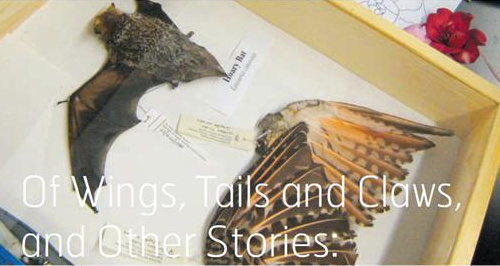This article was originally published in Synergy, Journal of UBC Science, Issue 01/2011. Read it in its original context.
Seeing, smelling and touching whale bones and other animal specimens. Hearing about the thievery, conspiracy, cooperation and other dramas that unfold daily in ecosystems. Conducting experiments and developing theories about the interconnectedness of all living things. These are the kind of rich, hands-on experience students can have at UBC’s Beaty Biodiversity Museum, scheduled to open in spring 2010.
In preparation for the museum’s opening, members of the outreach team have been developing and
piloting educational programs. The museum will offer school programs, teacher training workshops, lecture series and fun science-related events for the whole family. Already, visiting students have had an opportunity to sneak a behind-the-scenes peek, explore some of the two million natural history specimens, interact with researchers associated with the museum—and picture themselves as future scientists if so inspired.
Piloting Future Scientists, Discovering Beauty in Biodiversity
This spring, four grade six and seven classes visited campus to find out what plasticine and coloured pencils have to do with biology. In collaboration with UBC Michael Smith Laboratories’ education arm, museum staff designed a program to get students thinking across disciplines.
Graduate students in biology and visual arts paired up to develop field trips where students explored the interconnectedness of the biological world and the beauty in biodiversity by creating nature-inspired
art projects. The school kids interacted with young scientists, while the grad students—currently working in either the studio or the field—were able to hone their teaching skills.
The pilot biology–visual arts program tested various ways in which students could discover their creative and analytical sides. One variation challenged students to think about how organisms can adapt to diverse environments over the course of evolutionary time.
Students were encouraged to ask questions like: “How might wings evolve? What purpose could a big beak serve? Why slither when you can walk?” Beginning with a drawing of a fictitious simple organism that has no visible adaptations, and using photos and descriptions of four kinds of habitat, students then added (on tracing paper) their own adaptations—wings, claws, tails, fangs-creating fantastical superorganisms.
In another variation, students interlinked a range of species (drawn on cards) into a food web—asking themselves: “Where do these organisms live and what do they eat?” With a new awareness of ecological interactions, the students then walked to nearby woods and collected specimens of flowers, tree bark, pine cones and lichens. Back in the lab, each student created biodiversity artwork inspired by—and including—some of their collected “museum specimens.”
In another pilot program, students toured the Beaty Museum’s Fish Collection. This collection is one of UBC’s largest and oldest, with over half a million specimens, many of them older than the students’ grandmothers. Walking the narrow aisles between shelves stacked with jars of fish specimens floating in preservative can be a little spooky. But the students were thrilled to see deep-sea fish, hear how flatfishes’ eyes migrate from one side of the head to the other during adolescence, and hold their noses while peering into a five-foot-long container that stores a giant sturgeon head.
In Victoria, hundreds of students visited the Blue Whale Project Workshop, where whale bones from Prince Edward Island are being prepared for museum display. The students walked between the whale’s two 1,500-pound jawbones, stood inside the reconstructed ribcage (in the belly of the beast!), tried their hand at reconstructing the whale’s flipper by placing cleaned flipper bones on the life-sized print of the flipper X-ray, and participated in a hands-on demonstration of how toothed whale feeding differs from baleen whale feeding. More than a thousand children and adults attended summer open houses to smell the whale for themselves.
Expanding Possibilities: Field Trips, Nature Clubs, Science Workshops
Once the museum opens its doors to the public, the new physical space will allow for an even wider selection of school and outreach programs to help young people and community members understand what biodiversity is, how it emerged and why it matters. A whole slate of field trips, nature clubs and family events is planned.
Field trips will give students a deeper understanding of the richness and complexity of the natural world.
A wide variety of school programs will be linked to the provincial integrated resource packages, which prescribe curriculum learning outcomes, and they will be tailored to the grade level, interests and needs of the visiting class. Camp groups, after-school clubs, home schoolers and preschool groups are also welcome. The programs will feature the 80-foot blue whale skeleton, and the arts will continue to be integral, as a way to encourage careful observation and examination of the natural world.
The museum’s offerings for children will not stop at field trips. Also planned is a club for nature and research enthusiasts, a story hour for young children (and the young at heart) and a series of nature walks for families. Many of the museum’s events are family friendly, such as FestEVOLVE, an evolution celebration held in September, which included a bug hunt, a build-your-own-microscope workshop and tips on wildlife tracking.
There will also be opportunities for teachers to explore the museum and participate in teacher nights and workshops. UBC scientists will support programming aimed at increasing teacher confidence and renewing—or perhaps instilling—a passion for teaching natural sciences. These programs will connect teachers to current research and innovative teaching techniques.
The Beaty Biodiversity Museum education and outreach program invites you to discover how rich the world around you is and to feel what a thrill discovery can be. Check out the exciting possibilities at www.beatymuseum.ubc.ca.

